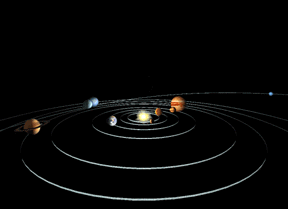Image of a star in the constellation Taurus surrounded by a ring of dust.
Click on image for full size
Image courtesy of STScI
Hubble Images Possible Planet-Forming Systems
News story originally written on February 12, 1999
Scientists used the Hubble Space Telescope to take pictures of stars in
the constellation Taurus. The stars have rings of dust around them.
Scientists think that planets might be forming from the dust. They want
to study these stars to find out how our Solar System
formed.
It's hard to see dust rings like the one in the picture on the left. We
can only see the ones that are edge-on. That way the dust blocks most of
the light from the stars. Otherwise it would too bright to see the dust.
You might also be interested in:

Scientists believe that the solar system was formed when a cloud of gas and dust in space was disturbed, maybe by the expl osion of a nearby star (called a supernova). This explosion made waves in space
...more
The Hubble Space Telescope (HST) is really neat! It was first launched in 1990, but scientists started building it in the 1970's! We have found all kinds of objects like stars, nebulae and galaxies. The
...more
It was another exciting and frustrating year for the space science program. It seemed that every step forward led to one backwards. Either way, NASA led the way to a great century of discovery. Unfortunately,
...more
The Space Shuttle Discovery lifted off from Kennedy Space Center on October 29th at 2:19 p.m. EST. The sky was clear and the weather was great. This was the America's 123rd manned space mission. A huge
...more
Scientists found a satellite orbiting the asteroid, Eugenia. This is the second one ever! A special telescope allows scientists to look through Earth's atmosphere. The first satellite found was Dactyl.
...more
The United States wants Russia to put the service module in orbit! The module is part of the International Space Station. It was supposed to be in space over 2 years ago. Russia just sent supplies to the
...more
A coronal mass ejection (CME) happened on the Sun last month. The material that was thrown out from this explosion passed the ACE spacecraft. ACE measured some exciting things as the CME material passed
...more









